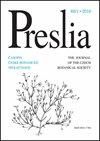Do threatened species occur in species-rich vegetation?
IF 2.9
2区 生物学
Q1 PLANT SCIENCES
引用次数: 0
Abstract
Conservation strategies often assume that the total number of species at a specific location can be used as a proxy for other biodiversity dimensions, such as, the presence of rare and threatened species. However, the validity of this assumption remains unclear, particularly at the plot scale. Here, we used ~17,000 vegetation plots sampled across the Czech Republic to examine the relationship between the occurrence of threatened plant species and species richness in temperate forest and grassland communities. For each individual species, the median, range, and skewness of species richness in the plots in which it occurred were used to define its distribution along the community species richness gradient. These parameters were then compared for threatened and non-threatened species. We also compared the observed values with those obtained under a null expectation to test whether threatened species occurred at random with respect to species richness. On average, threatened species occurred in species-richer plots than non-threatened species. In addition, threatened species assembled non-randomly with respect to species richness, as they occurred more often in species-richer forests but speciespoorer grasslands than expected by chance. The occurrence pattern of threatened species in relation to species richness was driven by the species-pool sizes of individual habitats. Threatened species associated with low species richness were thus found in extreme habitats, such as bogs, salt marshes, peat forests, and alpine grasslands characterized by small species pools. In contrast, threatened species associated with high species richness were often found in subcontinental semi-dry grasslands and dry thermophilous forests with large species pools. Threatened species also occurred over shorter species richness gradients and were more symmetrically distributed along these gradients than non-threatened species. These patterns may reflect a high habitat specialization of threatened species or strict requirements for habitat quality. We therefore suggest that species richness is a poor indicator of conservation value when comparing habitats and geographic regions. Targeting specific habitats and using the presence or percentage of threatened or specialized species as indicators may provide better assessment of conservation value.濒危物种是否出现在物种丰富的植被中?
保护策略通常假设特定地点的物种总数可以作为其他生物多样性维度的代表,例如稀有和受威胁物种的存在。然而,这种假设的有效性仍然不清楚,特别是在地块尺度上。在这里,我们使用了捷克共和国近17,000个植被样地的样本来研究温带森林和草地群落中濒危植物物种的发生与物种丰富度之间的关系。对于每个物种,利用其发生样地的物种丰富度中位数、范围和偏度来确定其沿群落物种丰富度梯度的分布。然后将这些参数用于受威胁物种和非受威胁物种进行比较。我们还将观测值与零期望下的观测值进行了比较,以检验物种丰富度方面受威胁物种是否随机发生。平均而言,受威胁物种比非受威胁物种发生在物种丰富的样地。此外,在物种丰富度方面,受威胁物种的聚集不是随机的,因为它们更多地发生在物种丰富的森林中,而物种较少的草地中。受威胁物种发生格局与物种丰富度的关系受个体生境物种库大小的驱动。物种丰富度较低的濒危物种主要分布在物种池较小的沼泽、盐沼、泥炭林和高寒草原等极端生境。物种丰富度高的濒危物种多分布在次大陆半干草原和物种库较大的干热森林。受威胁物种也出现在较短的物种丰富度梯度上,并且在这些梯度上的分布比非受威胁物种更加对称。这些模式可能反映了受威胁物种的高度栖息地专业化或对栖息地质量的严格要求。因此,我们认为在比较生境和地理区域时,物种丰富度是一个较差的保护价值指标。以特定生境为目标,利用受威胁或特殊物种的存在或百分比作为指标,可以更好地评估保护价值。
本文章由计算机程序翻译,如有差异,请以英文原文为准。
求助全文
约1分钟内获得全文
求助全文
来源期刊

Preslia
生物-植物科学
CiteScore
5.20
自引率
29.40%
发文量
8
审稿时长
>12 weeks
期刊介绍:
Preslia is a peer-reviewed scientific journal publishing original research papers on plant systematics, morphology, phytogeography, ecology and vegetation science, with a geographical focus on central Europe. The journal was founded in 1914 and named in honour of brothers Jan Svatopluk Presl (1791–1849) and Karel Bořivoj Presl (1794–1852), outstanding Bohemian botanists. It is published quarterly by the Czech Botanical Society.
 求助内容:
求助内容: 应助结果提醒方式:
应助结果提醒方式:


